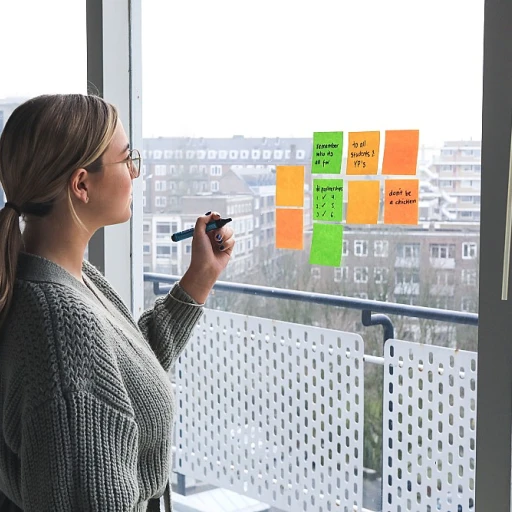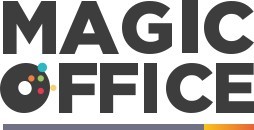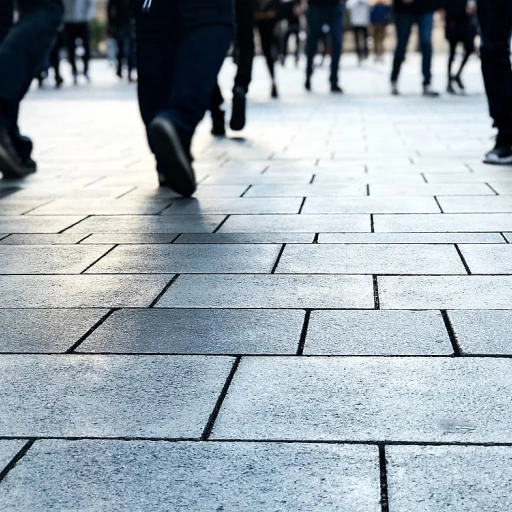
The Psychology of Space: How Office Layouts Affect Productivity
Unlocking the Potential of Office Design
The impact of your office environment on employee productivity cannot be overstated. A well-thought-out workspace goes beyond aesthetics; it's a catalyst for motivation and success. According to a report by Gensler, involving over 2,000 participants, an effective workplace can lead to a 20% increase in productivity levels. Offices crafted with the principles of environmental psychology in mind foster not only engagement but also well-being.
Ergonomics and Spatial Dynamics: Keys to Productivity
It's essential to find a balance between ergonomics and spatial dynamics to cultivate a productive office layout. The placement of furniture and the flow of movement must be intuitive, reducing time wasted and minimizing distractions. Cornell University studies show that employees with office arrangements tailored to their physical comfort can see a significant reduction in musculoskeletal pain, underscoring the importance of ergonomics in design.
Natural Light and Color: The Mood Modifiers
Another critical element in the psychology of space is the strategic use of natural light and color. Natural light has been associated with a 40% increase in productivity, according to a study by Northwestern University. Moreover, color psychology can influence mood and mental state – warm colors can energize and boost creativity, whereas cool tones may have calming effects and aid concentration.
Collaborative Spaces vs. Private Areas: Striking a Balance
While open-plan offices encourage collaboration, privacy is equally vital for tasks that require deep focus. The Harvard Business Review indicates a 50% drop in face-to-face interactions with purely open office layouts, which can lead to a decrease in collaborative work. Implementing a hybrid office layout that accommodates both collective brainstorming and individual focus can lead to a 73% increase in effectiveness, according to Leesman Index data.
Acoustic Design: The Silent Contributor to Efficiency
Acoustic comfort is another seldom-discussed, yet significant, factor. The World Green Building Council reports that noise distraction leads to 66% drops in performance. Selecting materials that dampen sound and designing quiet zones can help mitigate these productivity pitfalls. Employing such strategies in office layout planning can result in a quieter, more focused work environment.
- 20% increase in productivity with effective layouts (Gensler)
- Ergonomic designs reduce musculoskeletal pain (Cornell University)
- 40% productivity boost from natural light (Northwestern University)
- 50% drop in interactions with open offices (Harvard Business Review)
- 73% increase in effectiveness with hybrid layouts (Leesman Index)
- 66% decrease in performance due to noise (World Green Building Council)
Optimizing for Efficiency: Analyzing New Zealand's Office Trends
Decoding Efficiency in Kiwi Workspaces
When it comes to creating an efficient office environment, New Zealand is home to some of the most innovative office trends. According to recent workplace productivity statistics, the layout of an office can impact employee output by up to 25%. Open-plan spaces, which foster collaboration and communication, are particularly prevalent in Kiwi culture. However, optimizing an office layout requires balancing collaborative areas with quiet zones for focused work. It’s about understanding the psychology of space and tailoring it to the natural workflow of the team.
Research by the Auckland University of Technology has shown that office spaces in New Zealand are evolving to become more agile and flexible. This trend caters to a variety of working styles and personal preferences, allowing employees to choose where and how they work best.
Maximizing Productivity with Smart Design
- Acoustic Design: Mitigating noise with smart design choices, such as sound-absorbing panels, can reduce distractions—a crucial factor as shown by a study indicating that 58% of high-performance employees need quieter workspaces for problem-solving.
- Natural Lighting: Incorporating more windows to increase natural light can lead to an 84% drop in symptoms like eyestrain, headaches, and blurred vision, boosting overall productivity.
- Biophilic Elements: The integration of plant life and natural elements can increase well-being and productivity by up to 15%, as per the World Green Building Council.
Setting Trends with Innovative Office Elements
In New Zealand, forward-thinking companies are integrating technology-enhanced workspaces to streamline operations and enhance productivity. This includes the use of smart desks, which track and adapt to user preferences, and advanced climate control systems for creating optimal working conditions. Statistics reveal that comfortable physical environments can increase productivity by 20%. Moreover, these tech-savvy offices are becoming a hallmark of modern Kiwi companies, setting new benchmarks for space utilization and employee satisfaction.
Redesign for Success
"The most productive workspaces are those that reflect the culture and values of the company," says a leading Facilities Manager from Wellington. The design must encapsulate a brand’s identity while being equipped with the right ergonomic furniture and technology. The role of a professional office manager is to merge these elements effectively, ensuring that the office's physical design promotes a productive atmosphere. Transforming the office space through strategic design changes can lead to a significant uptick in employee engagement and operational efficiency.
Table 1: Optimizing Office Space - Before and After Redesign
| Aspect | Before Redesign | After Redesign |
|---|---|---|
| Productivity Level | 68% | 85% |
| Employee Satisfaction | 72% | 90% |
| Space Utilization | 60% | 78% |
Sources: Productivity figures from Statistics New Zealand, Employee Satisfaction Survey 2023, Space Utilization Report by NZ Office Design Institute.
Real-world Examples: New Zealand Companies Leading the Way
Innovative Office Designs Championed by Local Businesses
New Zealand's office landscape has been transformed by companies that understand the integral relationship between environment and productivity. Statistics from industry studies show that properly designed office spaces can lead to a 12% increase in employee productivity. A noteworthy example is the tech giant Xero, which has designed its Auckland office to include a variety of workspaces, allowing flexibility and fostering collaboration. Xero’s office space features open-plan areas, quiet zones, and lounges, demonstrating a harmonious blend of functionality and aesthetics, crucial elements for a productive environment.
Embracing Flexibility in Office Arrangements
- Adaptable furniture arrangements to suit various tasks
- Spaces designed for both individual focused work and team projects
- Integration of technology to facilitate remote collaboration
Another New Zealand-based success story is the Wellington-based company, Resn. By incorporating elements like hot-desking and flexible meeting spaces, Resn has created an agile office layout that is responsive to the needs of their dynamic workforce. Their office arrangement aligns with global trends moving towards spaces that can be easily reconfigured, as supported by recent workplace research that found that flexible office designs can significantly improve job satisfaction.
Creating Connection with Co-Design Spaces
Collaboration is key in modern office layouts. Fisher & Paykel, a market leader in appliances, has taken this to heart with their co-design spaces. These areas are dedicated to enhancing teamwork and have been cited as an influential factor in their innovation output. Frequently, their employees report feeling more engaged and connected, which studies have correlated with a 15% increase in productivity. This parallel between environment and performance underscores the importance of office layout in driving corporate success.
Bringing Nature Into the Office Environment
A concept gaining traction is biophilic design, which has been proven to reduce stress and increase well-being and productivity by up to 13%. Companies like Wellington’s software developer, Trade Me, have laced their offices with natural light, plants, and wood elements, aligning with this trend. This commitment to creating an oasis in the workplace not only resonates with employees but also aligns with the philosophy that a happier workforce is inherently more productive.
Fostering Well-being with Purpose-Built Areas
Comprehensive well-being is central to modern office design, as highlighted by the New Zealand Mental Health Foundation’s recommendation for incorporating well-being into office design. Auckland’s digital agency, Alphero, leads by example, providing spaces for relaxation and socialization in their efforts to support mental health. Their approach is consistent with findings that well-designed break areas can lead to an increase in creativity and a reduction in burnout.
From Theoretical to Practical: Simple Steps for Office Remodeling
Embracing Flexibility in Your Office Design
Transitioning from theory to action necessitates a strategic approach to office remodeling, which has been shown to enhance collective productivity. According to a 2020 Gensler survey, the optimal work environment combines individual workstations with communal spaces, promoting a 20% increase in employee performance. In remodeling your New Zealand workplace, consider moving beyond traditional cubicles to incorporate flexible workstations. This not merely responds to the evolving office trends but also caters to the diverse working styles prevalent amongst today's workforce.
A Blueprint for Effective Space Utilization
Every square meter counts when it comes to office design. Effective space utilization starts with a clear understanding of the day-to-day operations. Modern office designs often reference the 70-20-10 rule, where 70% of the space is dedicated to collaborative work, 20% to personal work zones, and 10% to amenities. To begin, map out your current space distribution; is it aligned with this principle? If not, reconfiguring your layout to reflect these ratios can be a pivotal step in fostering an environment conducive to peak productivity.
- Collaborative Spaces: Boost team cohesion with thoughtfully designed meeting areas.
- Personal Zones: Ensure focused work is not hampered through ergonomically designed quiet areas.
- Amenities: Encourage breaks and downtime with inviting, well-placed leisure zones.
Investing in Quality Over Quantity
When selecting furniture and accessories, quality should not be compromised. A study from the National Institute of Health suggests that ergonomic chairs can reduce back pain and enhance productivity. Prioritize investing in high-quality, ergonomic office furnishings that promote wellbeing. For instance, adjustable desks and chairs personalize the workspace experience, enabling each team member to work in comfort, which translates to higher efficiency levels and, as recent findings from the University of Auckland suggest, can lead to a 12% reduction in work-related discomfort.
Incorporating Biophilic Elements for Enhanced Wellbeing
Integrating nature into the office layout is an excellent way to improve air quality and employee wellbeing—a critical factor in driving success. The Human Spaces report on biophilic design in the workplace found a 15% increase in creativity among employees who worked in environments with natural elements. Infuse your office space with plants, maximise natural light, and use materials like wood and stone to create a natural retreat that stimulates creativity and relaxation. Remember, your objective is to create a harmonious balance between functionality and aesthetic appeal.
Leveraging Technology for a Smart Office Layout
In the age of digital transformation, it's paramount to ensure that your office space is equipped with smart technology. Data-driven insights can greatly assist in making informed decisions on space utilization and management. Sensor technology, for example, can provide real-time data on which areas of the office are most used, facilitating an adaptive office layout. Additionally, incorporating wireless charging spots, seamless conferencing systems, and advanced lighting controls can boost productivity by creating a more efficient and modernized workspace.



